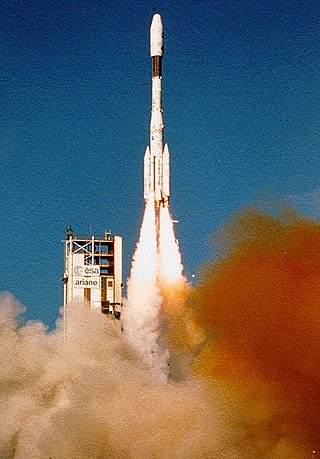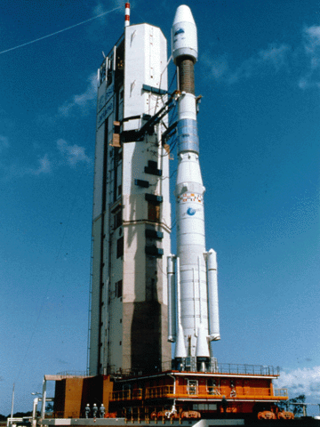
Arianespace SA is a French company founded in 1980 as the world's first commercial launch service provider. It undertakes the operation and marketing of the Ariane programme. The company offers a number of different launch vehicles: the heavy-lift Ariane 5 for dual launches to geostationary transfer orbit, the Soyuz-2 as a medium-lift alternative, and the solid-fueled Vega for lighter payloads.

Ariane is a series of European civilian expendable launch vehicles for space launch use. The name comes from the French spelling of the mythological character Ariadne. France first proposed the Ariane project and it was officially agreed upon at the end of 1973 after discussions between France, Germany and the UK. The project was Western Europe's second attempt to develop its own launcher following the unsuccessful Europa project. The Ariane project was code-named L3S.

The Ariane 4 was a European expendable launch vehicle, developed by the Centre national d'études spatiales (CNES), the French space agency, for the European Space Agency (ESA). It was manufactured by ArianeGroup and marketed by Arianespace. Since its first flight on 15 June 1988 until the final flight on 15 February 2003, it attained 113 successful launches out of 116 total launches.

The Diamant rocket was the first exclusively French expendable launch system and at the same time the first satellite launcher not built by either the United States or USSR. As such, it has been referred to as being a key predecessor for all subsequent European launcher projects.

The Guiana Space Centre, also called Europe's Spaceport, is a European spaceport to the northwest of Kourou in French Guiana, a region of France in South America. Kourou is located approximately 310 mi (500 km) north of the equator at a latitude of 5°. In operation since 1968, it is a suitable location for a spaceport because of its equatorial location and open sea to the east.

Ariane 1 was the first rocket in the Ariane family of expendable launch systems. It was developed and operated by the European Space Agency (ESA), which had been formed in 1973, the same year that development of the launcher had commenced.

Vega is an expendable launch system in use by Arianespace jointly developed by the Italian Space Agency (ASI) and the European Space Agency (ESA). Development began in 1998 and the first launch took place from the Centre Spatial Guyanais on 13 February 2012.

Soyuz-2 is a modernised version of the Soviet Soyuz rocket. In its basic form, it is a three-stage launch vehicle for placing payloads into low Earth orbit. Compared to the previous versions of the Soyuz, the first-stage boosters and two core stages feature uprated engines with improved injection systems. Digital flight control and telemetry systems allow the rocket to be launched from a fixed launch platform, whereas the launch platforms for earlier Soyuz rockets had to be rotated as the rocket could not perform a roll to change its heading in flight.

ELA-3, is a launch pad and associated facilities at the Centre Spatial Guyanais in French Guiana. ELA-3 was operated by Arianespace as part of the expendable launch system for Ariane 5 launch vehicles. As of July 2023, 117 launches have been carried out from it, the first of which occurred on 4 June 1996. The final launch occurred on 5 July 2023.

ELA-2, short for Ensemble de Lancement Ariane 2, was a launch pad at the Centre Spatial Guyanais in French Guiana. It was used by Arianespace for two Ariane 3 launches, the second Ariane 2 launch in 1987, and all 116 Ariane 4 launches between 1988 and 2003. Following the retirement of the Ariane 4 in favour of the Ariane 5, ELA-2 was deactivated. In September 2011 the pad's mobile service tower was demolished using explosives.

The Ensemble de Lancement Soyouz (ELS) is a launch complex at the Guiana Space Centre in Kourou/Sinnamary, French Guiana. It was used by Soyuz-ST rockets: modified versions of the Soyuz-2 optimised for launch from Kourou under Soyuz at the Guiana Space Centre programme.

TV-SAT 1 or TVSAT-1 was a West German communications satellite, which was to have been operated by Deutsche Bundespost. It was intended to provide television broadcast services to Europe, but it failed before entering service. It was built by Aérospatiale, was based on the Spacebus 300 satellite bus, and carried five Ku-band transponders. At launch it had a mass of 2,144 kg (4,727 lb), and an expected operational lifespan of eight years.

ArianeGroup is an aerospace company based in France. A joint venture between Airbus and Safran, the company was founded in 2015 and is headquartered in Issy-les-Moulineaux. It consists of three core groups: aerospace, defence and security. ArianeGroup is developing its next-generation two-stage Ariane 6 launch vehicle, intended to succeed the Ariane 5 rocket, which has had more than 110 launches. The new vehicle will be offered in two variants that will be capable of carrying between 10,350 and 21,650 kilograms. The first launch of Ariane 6 is expected to occur in 2023.

ELA-4, is a launch pad and associated facilities at the Centre Spatial Guyanais in French Guiana located along the Route de l'Espace in the Roche Christine site, between ELA-3 and ELS launch facilities. The complex is composed of a launch pad with mobile gantry, an horizontal assembly building and a dedicated launch operations building. ELA-4 is operated by Arianespace as part of the Ariane 6 program. As of November 2022 the first launch is scheduled for the fourth quarter of 2023.

Vega flight VV16, also called SSMS PoC Flight, was the 16th launch of the Vega rocket. The launch was also notable as it was the first Vega launch following the accident of the VV15 launch in July 2019 that caused the loss of FalconEye1 satellite.

TDF 1 or TDF-1 was a French communications satellite which was to have been operated by Télévision de France. It was intended to be used to provide television broadcast services to Europe, however it failed before entering service. It was constructed by Aérospatiale, based on the Spacebus 300 satellite bus, and carried five Ku-band transponders. At launch it had a mass of 2,144 kg (4,727 lb), and an expected operational lifespan of eight years.
TDF 2 or TDF-2 was a French communications satellite which was to have been operated by Télévision de France. It was intended to be used to provide television broadcast services to Europe, however it failed before entering service. It was constructed by Aérospatiale, based on the Spacebus 300 satellite bus, and carried five Ku-band transponders. At launch it had a mass of 2,144 kg (4,727 lb), and an expected operational lifespan of eight years.
Vega C flight VV22 was the 22nd launch of the Vega rocket. The rocket failed after launch and the mission was lost.
















